Quito’s BRT, a Model for Milwaukee?
Ecuadorian capital’s Bus Rapid Transit is cheap, convenient, fun to use.
As Milwaukee applies for a federal grant to implement a bus rapid transit corridor (BRT) from Downtown to Wauwatosa, it can cite data from numerous other cities around the world which have them. BRT systems can help reduce traffic congestion and provide fast, affordable transportation for all in their vicinity. I was recently in Quito, Ecuador to attend the United Nations Habitat III conference and was able to observe and ride that city’s BRT. By and large I was quite impressed with Quito’s implementation. There may be lessons to be learned for Milwaukee.
Quito is the sprawling mountainous capitol of Ecuador in South America. Located over 9,000 feet above sea level, its population as of the 2001 census was 1,841,200 in the city with an additional 427,506 people in the metropolitan area. The metropolitan area is composed of approximately 1,640 square miles while the urbanized area is around 77 square miles. In the urbanized area that leaves a population density of approximately 23,912 people per square mile.
Quito was the first Latin American city outside Brazil to install a BRT corridor. The Latin American movement toward BRT began as in 1972 in an effort to enhance cheap, convenient, and prompt public transit available for all. Researchers have since noted positive unintended consequences which include less noise and cleaner air. As of 2012 there were around 120 cities in the world with BRT corridors. A key reason is that BRT systems can be three to ten times cheaper than rail alternatives with similar passenger loads.
While in Quito I stayed in a hostel near a bus stop on one of the city’s arterial roads: La Calle 6 de Diciembre, or December Sixth Street. The road is wide enough to accommodate a bus station in the middle and six narrow lanes with two pairs of three lanes going in opposite directions. I was unable to measure, but the lanes appeared to be narrower than most U.S. lanes.
The buses utilize the center-most lanes as dedicated lanes separated by thin concrete medians. Only emergency vehicles may additionally use the bus lanes. All other traffic is forced to use the four outermost lanes. In this way public transit is incentivized through greater speed unlike present buses in Wisconsin which are forced to drive in mixed traffic.
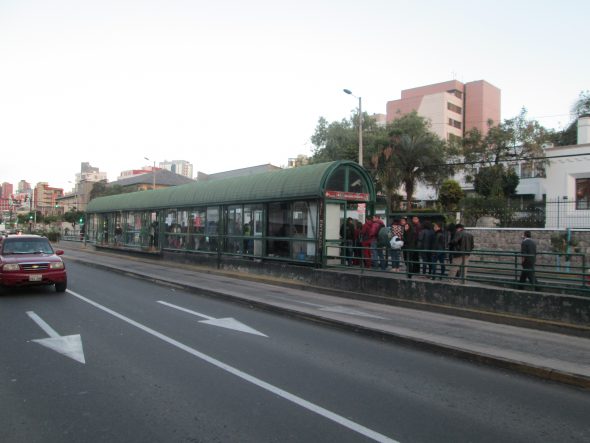
BRT riders in Quito enter the covered stations on one side, pay their $0.25 fare, and exit out the other. Photo by Ken Smith.
Congruent with the central lanes, the stops are designed to allow the buses to load at sidewalk level. The advantage of this over “kneeling” buses, which one may see in Milwaukee or Madison, is that while the latter is effective at helping people with difficulties stepping up, it inevitably delays bus travel. In a big city every second counts. Milwaukee County’s proposal intends to load at level.
BRT riders in Quito enter the covered stations on one side, pay their $0.25 fare, and exit out the other. Yes, the fare is 25 cents in actual United States coinage! This allows for efficient ingress and egress at each stop. Each station is likewise staffed to ensure rider payment. Details of Milwaukee’s BRT stations were not clear from publicly available documents, however, the proposal does intend to have fare payment prior to boarding.
Overall, my traveling companion and I found this model of transit highly efficient at moving people and buses as quickly as possible under the constraints of Quito’s built environment. The only possible critique we had was that private buses were forced to share space with mixed traffic. We thought it might be better to allow private buses to share the public bus lane to further incentivize bus use.
What are the takeaways for Milwaukee?
I found Quito’s BRT a cheap and convenient way to get around. Paying before entering the bus facilitated faster travel times and it was fun zipping through traffic faster than regular automobiles. Milwaukee’s BRT could be very helpful in making faster, affordable transportation available to everyone, particularly those lacking a car.
That being said, Milwaukee’s BRT is still very much in its infancy. The governments of the city, county, and Wauwatosa have only approved BRT conceptually. Now Milwaukee County can apply for federal funds. There has been no determination on whether or not the BRT lanes would run through the middle or sides of the road and the project is likely to face opposition from those who will dislike fewer street parking spaces and generally believe BRT is a waste of money. And winning a federal grant is crucial: without it the project is unlikely to proceed.
With Quito as an example, we the general public can weigh the advantages and disadvantages of BRT and work with our local governments to make it happen or not.
Quito’s BRT
Ken Smith is a Milwaukee native and graduate student at UW – Madison. He studies in the LaFollette School of Public Affairs and Department of Urban and Regional Planning.
More about the East-West BRT Line
- Transportation: Off-Board Fare Collection Begins on Connect 1 - Graham Kilmer - Apr 16th, 2024
- Streetcar Begins Daily Service To The Couture, BRT Will Soon Follow - Jeramey Jannene - Apr 11th, 2024
- Transportation: Connect 1 Ridership Continues to Grow - Graham Kilmer - Nov 23rd, 2023
- Transportation: Battery Electric Buses Will Return This Fall - Graham Kilmer - Sep 8th, 2023
- Transportation: MCTS Pulling New Battery Electric Buses From the Road - Graham Kilmer - Aug 24th, 2023
- MKE County: Local Leaders Celebrate Launch of BRT Service - Graham Kilmer - Jun 5th, 2023
- Transportation: Milwaukee’s First Bus Rapid Transit Line Is Open for Business - Graham Kilmer - Jun 4th, 2023
- Transportation: New Bus Rapid Transit Line Launches Sunday, GoldLine Ends - Graham Kilmer - Jun 3rd, 2023
- Transportation: Federal Funds Creating Two New East-West BRT Stations - Graham Kilmer - May 19th, 2023
- Transportation: First 4 Months of BRT Rides Will be Free - Graham Kilmer - May 9th, 2023
Read more about East-West BRT Line here
Transportation
-
MCTS Adds 28 New Buses
 Jul 13th, 2024 by Graham Kilmer
Jul 13th, 2024 by Graham Kilmer
-
MCTS Designing New Bus Shelters
 Jul 10th, 2024 by Graham Kilmer
Jul 10th, 2024 by Graham Kilmer
-
MCTS Updates RNC Bus Detours To Better Serve Downtown, Riders
 Jul 9th, 2024 by Jeramey Jannene
Jul 9th, 2024 by Jeramey Jannene


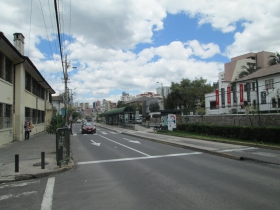
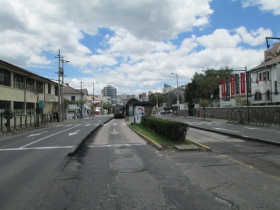
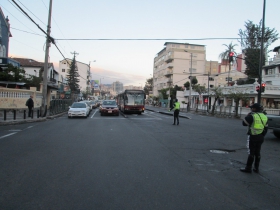
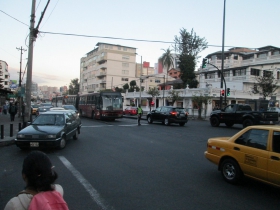
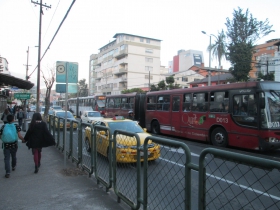
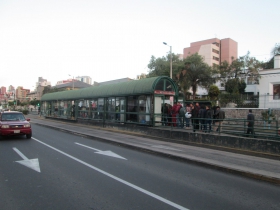




















How about reworking that last sentence: “With Quito as an example of what Milwaukee lost from long established mass & rapid transit service, we can weigh the advantages and disadvantages of recreating an interest and need to recreate that lost network and work with our local governments to make its return happen or not.
(n.b. a quick poll of people I come across: a twenty-something haircutter refused to believe there had once been an extensive mass & rapid transit service in the Milwaukee area; a thirty-something clerk in an office services store declared mass transit & rapid transit service would take away jobs. There ya go.)
Writing as a citizen in Quito, yes, I can say our trolleys and streetcars are great. However, we need much more of them because they are often overcrowded, with the result that people are pickpocketed and women, in particular, suffer groping. And Mr. Smith really should have thought more deeply before he wrote the following: “BRT riders in Quito enter the covered stations on one side, pay their $0.25 fare, and exit out the other. Yes, the fare is 25 cents in actual United States coinage!.” Yes, Mr. Smith, but that’s because wages and operational costs in Ecuador are much lower here than in any city in the United States. Different economies, ya know?
Hmm, you failed to notice that the busses were hugely polluting and absolutely rammed at rush hour? Or that they are havens for pick pockets. You got lucky.
25c is cheap. But then so is labour here. And the busses are subsidised.
They are however, a nice idea.
Here are a few other points the article does not include:
1, The BRT has feeder buses that service areas beyond the BRT line and, when one gets on a feeder, he/she gets the equivalent of a transfer, i.e., pays no more, as the feeders pull into the BRT station.
2. Eighty per cent of Quito´s residents have no personal vehicle.
3. The elderly, minors, university students, and people with handicaps travel for 12 cents which is, indeed, cheap, but 50% of Ecuador’s working age population is under- or unemployed and a large percentage of the formally employed earn the minimum monthly minimum wage, around $350, which comes to les than $2.20 an hour, which covers around half of the price of a basket of basic goods and services so, yes, transportation is cheap if you are thinking in terms of Stateside cost of living, not if you are thinking in terms of Ecuador’s. .
Now for a more constructive discussion. Pretty much everyone I know who is local to Quito felt that the Habitat conference was an expensive joke. Few local people knew what it was for, few realised that they could attend. It’s been really hard to work out what the purpose of the conference was and what of use came out of it. It was a vanity project locally.
For people here, it’s been a bit embarrassing. The current mayor has completely failed to improve the city from a transport perspective. The ‘eco’via (what you call be BRT) is extremely crowded and belches out terrible diesel fumes. I used to cycle behind it, as the city does not have a useful cycle path network – but stopped when I could not deal with the fumes. A casual visitor would not realise that all the nicely painted cycle paths had just been put there a couple of weeks before the conference, and would not know that they are already falling into disrepair (many the bollards have been removed or knocked down already, the lanes are treated as parking places by cars and taxis. That said, to be fair there have been some real improvements, but how come they all got done in a few weeks before a conference, when we’ve been pushing for them for years? Up till now we’ve seen many cycle lanes put in by the previous mayor simply removed by the current mayor, Rodas. Cars are allowed (unofficially) to park on the sidewalks, with no fines. Pedestrians thus have to walk on the road! There is a metro in development, but it’s years behind schedule. Did you notice that there are virtually no proper pedestrian crossings on the road with the Ecovia?
While private cars are regularly tested for emissions, the busses due to clear corruption continue to belch black smoke so bad that visibility is hugely reduced when they pass. All the while the city’s air quality statistics are clearly forged.
On the ecovia itself, people are regularly pick-pocketed, while women are regularly sexually harassed. Returning to my country (UK) for a while, it took me a long time to stop clutching my bag to me on public transport.
I’d look elsewhere for solutions. If you want to visit a South American city with great solutions, try Medellin, Colombia. Otherwise, come visit Europe. Amsterdam, Berlin, Copenhagen, even London.
Other than that, I’d be really interested in your views of the Habitat III conference, which sadly I could not get to. I’d like to write something about it… and would like to get something positive if possible!
-Did you find it useful?
-What good things do you think will come of it?
Thank you all for your feedback on my article. Please forgive me if I came off as disingenuous in my writing. This was not intended to be exhaustive. Also, the intended audience for this piece is an American one, particularly in southeast Wisconsin.
Yes I am aware of there being economic differences between Ecuador and the United States, hence a favorable exchange rate for Americans. I did not mean to suggest that we here in Milwaukee would have 25 cent bus fare. The going flat fare for public transit in the US is generally $2 to $3. Nonetheless, as an American it was bewildering to pay only a quarter to ride public transportation.
As for your other critiques, every city in every society has its problems. My goal was to focus on what Americans might be able to learn from the best aspects of Quito’s BRT so that we may adapt them to our local circumstances. By and large American cities have deplorable mass transit infrastructure and many are working on ways to address that for both social and economic reasons. Two individuals associated with local government have contacted me with interest regarding this piece.
Many of the problems you cite can be addressed with vigorous enforcement and a strong civil society, sometimes easier said than done. Others may be unique to the social challenges faced in Ecuador. I’m not ignorant of the crime problem in Quito, I was robbed at knifepoint near a major tourist attraction! We in the US of course have our own social problems as well. And yes I’ve been to many of the great cities of Europe and seen their wonderful examples of efficient public transportation.
I’m sorry you and your Ecuadorian friends have heard nothing but negatives regarding Habitat III. I found it a great learning experience and way to network with people from all over the world. Roughly 30,000 people participated with a mere 10,000 of them being foreigners, so many Ecuadorians participated. I befriended several while I was there.
I did find Habitat III quite useful and do believe good will come of it. I hope to write a piece about Habitat III with the editor’s blessing within the coming week or so. However, for this publication it will be Milwaukee-centric. I would be happy to link to it from here.